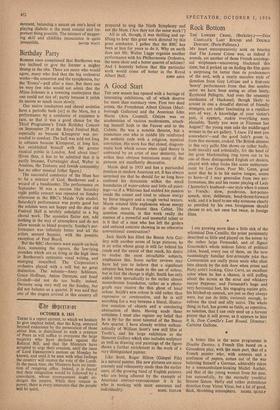A Good Start
THE new season has opened with a barrage of interesting exhibitions, all of which deserve far more than summary view. First two dead artists, the Frenchman Albert Gleizes (Marl- borough Galleries) and the American John Marin (Arts Council). Gleizes was an academician of various modernisms, attach- ing himself both to the Fauves and to the Cubists. He was a notable theorist, but a passionate one who in middle life reinforced his testhetic code with a religious, mystical conviction. His work has that closed, diagram- matic look which comes when rigid theory is embraced by an artist of easy dexterity, but within their obvious limitations many of the pictures are excellently decorative.
Marin died in 1953 and has a patriarchal position in modern American art. It has always surprised me that he should for so long have confined his dynamism within the small boundaries of water-colour and little oil paint- ings—as if a Whitman had stabled his passion inside the sonnet and tried to release energy by fierce imagery and a rough verbal texture. Marin created little explosions whose energy is often more Futurist than Cubist. The question remains, is this work really the essence of a powerful and masterful talent or is it that of a man who has left the girders and unfaced concrete showing in an otherwise conventional construction?
Jack Smith has filled the Beaux Arts Gal- lery with another series of large pictures; he is an artist whose grasp is still far behind his reach and the extent of that reach, his desire to realise the most intractable subjects, emphasises this. Some earlier reviews may have led you to believe that a significant advance has been made in the use of colour, but in fact the change is slight. Smith has only added tints sporadically to the earlier almost monochrome foundation, rather as a photo- graph may receive the thin ghost of local colour. Smith's new colour is odd rather than expressive or constructive, and he is still searching for a way between a literal. illustra- tive notation of objects and a convincing abstraction of them. Having made these criticisms I must also register my belief that he is by far the most talented of the Beaux Arts quartet. I have already written enthusi- astically of William Scott's new still lifes at Tooth's, and his large exhibition at the Hanover Gallery which also includes sculpture as well as drawing and paintings of the figure shows a further enrichment in the work of a very distinguished painter.
Like Scott, Roger Hilton (Gimpel Fils) is a natural painter. His new pictures are more coarsely and vehemently made than the earlier ones; of, the growing band of English painters who are being affected by the example of American abstract-expressionism it is he who is working with most assurance and individuality. BASIL TAYLOR


















































 Previous page
Previous page